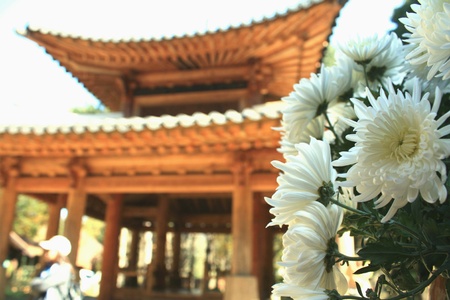Understanding Feng Shui and Its Relevance to British Gardens
Feng Shui, an ancient Chinese philosophy, is centred on the harmonious arrangement of spaces to promote positive energy flow, or “chi”. While often associated with Eastern interiors, its core concepts—balance, natural elements, and mindful placement—are universally applicable, including to the quintessential British courtyard. At its heart, Feng Shui encourages us to create environments that nurture wellbeing and clarity by thoughtfully considering the interaction between people and their surroundings.
Applying Feng Shui principles to a traditional British garden isn’t about replacing classic features with overtly Asian aesthetics; rather, it’s about enhancing what already exists. The historic British courtyard—with its brick walls, stone paving, and cottage planting—offers an ideal canvas for subtle transformation. By integrating Feng Shui, you can boost the garden’s ambience and functionality, turning it into a tranquil retreat that feels both rooted in local heritage and uplifted by ancient wisdom.
In essence, adopting Feng Shui in your outdoor space means recognising the influence of layout, materials, and plant selection on mood and energy. Whether your goal is relaxation, contemplation, or sociability, these principles help guide each decision—from where you place a bench to how you arrange pots—ensuring your courtyard not only looks inviting but also feels genuinely restorative.
2. Assessing Your Courtyard: Key Elements and Natural Advantages
Before you embark on transforming your British courtyard into a Zen-like sanctuary, it is crucial to thoroughly assess its unique characteristics. By evaluating the orientation, existing features, and local microclimate, you can apply Feng Shui principles more effectively and create an environment that harmonises with both nature and your lifestyle.
Understanding Your Courtyard’s Orientation
The direction your courtyard faces has a profound influence on energy flow and how you use the space. In the UK, courtyards facing south typically benefit from more sunlight, while north-facing ones tend to be cooler and shadier. East- or west-facing courtyards experience varying light conditions throughout the day, which can affect plant selection and seating arrangements.
| Orientation | Typical Light | Feng Shui Consideration |
|---|---|---|
| North-facing | Low light, cool | Use bright plants and reflective surfaces to enhance energy (Qi) |
| South-facing | Abundant sunlight, warm | Create shaded areas for balance; use water features to cool Qi |
| East-facing | Morning sun, afternoon shade | Ideal for meditation spots; place vibrant flowers in eastern section |
| West-facing | Afternoon sun, morning shade | Add calming elements like bamboo screens to soften late-day energy |
Evaluating Existing Features and Structures
Your British courtyard may already include historic brick walls, established trees, sheds, or traditional paving. Take stock of these elements as they will either support or challenge your Feng Shui goals. For example, sturdy garden walls can offer protection (symbolising support in life), but too much hard landscaping might stifle positive energy flow if not balanced with soft greenery or water.
Checklist: Existing Features to Note
- Mature trees or shrubs – Offer natural shade and privacy but may need pruning to avoid blocking beneficial energy.
- Paving and pathways – Observe how they guide movement; curved paths are preferable for gentle Qi flow.
- Sheds or outbuildings – Ensure they are well-maintained and not creating visual clutter.
- Water sources – Existing ponds or fountains add tranquillity but must be kept clean for auspicious Feng Shui.
- Seating areas – Consider if current placements invite relaxation or feel cramped.
Accounting for the British Microclimate
The UK’s temperate climate brings both opportunities and challenges. Frequent rainfall supports lush planting but also requires good drainage solutions. Wind exposure varies regionally—coastal courtyards may need sheltering hedges, while urban spaces might benefit from vertical gardens to soften harsh lines. Recognise these factors when planning your sanctuary so that your chosen features endure through the seasons.
Key Microclimate Factors:
- Rainfall: Ensure patios have adequate run-off; select moisture-loving plants for damp corners.
- Wind: Install trellises or living screens to buffer prevailing breezes without impeding airflow entirely.
- Frost: Choose hardy species for exposed spots; use pots for tender specimens that can be moved indoors in winter.
- Shade: Embrace shade-tolerant ferns and mosses to enhance a tranquil mood typical of Zen-inspired design.
A careful assessment of these key elements will enable you to tailor Feng Shui techniques specifically for your British courtyard, making the most of its natural advantages while addressing any limitations. This thoughtful approach lays a strong foundation for creating a truly harmonious outdoor retreat.
![]()
3. Choosing Materials and Features that Complement British Style
Blending the timeless elegance of a British courtyard with the calming influence of Feng Shui starts with carefully selecting materials and features that honour both traditions. To achieve this, it is important to identify elements that reflect quintessentially British tastes yet align with Feng Shui principles for harmony and energy flow.
Stonework: A Foundation of Character
Classic British courtyards often feature natural stone such as Yorkstone or slate, which offer a sense of permanence and understated charm. These materials not only resonate with traditional British aesthetics but also provide grounding energy, a key concept in Feng Shui. Opt for irregular patterns or curved pathways rather than strict geometric lines; this allows Chi (energy) to meander gently through the space, avoiding stagnation.
Water Features: Serenity Meets Sophistication
Water is central to both British garden design and Feng Shui, symbolising prosperity and tranquility. Consider a subtle, low-maintenance water feature such as a stone trough fountain or a small pond edged with mossy rocks. The gentle sound of water will introduce soothing acoustics while enhancing positive energy flow. Place the water feature in the east or southeast section of your courtyard to maximise its auspicious effects according to Feng Shui guidance.
Plant Selection: Harmonising Texture and Energy
Select plants that evoke classic British sensibilities—think ferns, box hedges, lavender, and climbing roses—while also supporting Feng Shui balance. Evergreens bring stability year-round, while fragrant herbs like rosemary add sensory richness without overwhelming the senses. Arrange plantings in soft, flowing clusters rather than rigid rows to encourage organic movement of Chi throughout the garden.
Decorative Elements: Subtlety and Meaning
When introducing ornaments or decorative features, opt for subtlety over excess. Wrought iron benches, weathered terracotta pots, or simple lanterns can all add character without creating visual clutter. In Feng Shui, avoid sharp edges and harsh angles; instead, choose rounded shapes and natural finishes that invite calmness and inclusivity.
Bridging Tradition with Tranquility
The key is thoughtful integration: every material and feature should serve both aesthetic appeal and energetic harmony. By respecting local heritage while adhering to Feng Shui principles, you can create a courtyard that feels distinctly British yet universally serene—a true sanctuary in the heart of your home.
4. Optimising Flow and Creating Zones of Calm
Central to both Feng Shui and classic British garden design is the concept of flow—the unimpeded movement of energy (Qi) through space. In a courtyard, ensuring this flow means arranging pathways, seating, and focal points so that each element supports both relaxation and harmony. Below, we break down practical strategies for optimising movement and carving out tranquil zones in your British courtyard.
Enhancing Pathways: Guiding Qi Gracefully
Pathways serve as arteries for Qi, channelling energy throughout your outdoor sanctuary. Instead of straight, rigid paths, opt for gently curving walkways using local materials like York stone or reclaimed brick, which blend seamlessly with British aesthetics. A winding path not only feels more inviting but also encourages a slower pace—ideal for mindful strolls or quiet contemplation.
Comparing Pathway Styles
| Pathway Type | Feng Shui Benefit | British Garden Fit |
|---|---|---|
| Straight | Fast-moving Qi, can cause restlessness | Less traditional, often harsh in small courtyards |
| Curved/Meandering | Gentle flow of Qi, promotes relaxation | Classic cottage style, softens hardscapes |
Seating Areas: Anchoring Calmness
The placement of seating determines where energy settles and how people interact with the environment. Position benches or chairs against a solid boundary—like a brick wall or mature hedge—for a sense of security and support (a key Feng Shui principle known as the ‘Black Tortoise’). Face seating towards focal features such as a water bowl, an elegant planter, or even a small birdbath to invite gentle movement and visual interest.
Focal Points: Drawing Energy and Attention
A well-chosen focal point anchors energy and provides a destination within your courtyard. This could be an ornamental urn, a weathered sundial, or a compact Japanese maple in a glazed pot. Ensure it is visible from multiple angles but does not obstruct pathways—allowing both sightlines and Qi to remain unobstructed.
Suggested Focal Points for UK Courtyards
| Feature | Qi Effect | Cultural Resonance |
|---|---|---|
| Sundial | Stabilises energy, timeless calm | Classic British charm |
| Bamboo Water Feature | Invites soothing sound, flowing Qi | East-meets-West harmony |
| Potted Maple Tree | Adds seasonal vibrancy, rootedness | Subtle nod to Japanese Zen gardens with local adaptability |
Zoning Your Sanctuary: Layering Tranquility
Create distinct areas for different moods—perhaps a reading nook surrounded by lavender for solitude and another open space near fragrant herbs for socialising. Use hedges, trellises with climbing roses, or decorative screens to subtly divide these zones without creating blockages. Each area should feel intentional yet interconnected, supporting the overall sense of peace.
By thoughtfully enhancing pathways, positioning seating with care, and selecting meaningful focal points, you can ensure energy moves freely through your British courtyard—transforming it into a Zen-inspired retreat grounded in both Eastern wisdom and local tradition.
5. Incorporating British Wildlife and Sustainable Practices
To truly transform your British courtyard into a Zen-like sanctuary, it is essential to harmonise local ecology with the calming energy of Feng Shui. Rather than importing exotic plants or features, infuse your courtyard with native, wildlife-friendly touches that support biodiversity and sustainability—values which resonate with both modern British sensibilities and ancient Eastern philosophies.
Welcoming Native Species
Selecting indigenous plants such as lavender, foxglove, or wild primrose not only echoes the natural beauty of the UK but also attracts pollinators like bees and butterflies. This creates a living tapestry that changes with the seasons, enhancing the sense of tranquillity and connection to nature—a core aspect of Zen gardens. Consider installing bird feeders, nesting boxes, or even a small pond to invite robins, wrens, frogs, and hedgehogs, fostering a gentle coexistence between human space and local wildlife.
Sustainable Materials and Practices
Incorporate eco-friendly materials such as reclaimed brick, natural stone, or FSC-certified timber for pathways and seating areas. These materials not only reduce environmental impact but also age beautifully over time, lending an authentic character to your sanctuary. Utilise rainwater harvesting systems or permeable paving to manage water sustainably—a practical nod to both Feng Shui’s focus on harmonious water flow and contemporary green living.
Blending Tradition with Innovation
The integration of sustainable practices can go hand-in-hand with classic Zen elements. For example, use gravel or raked pebbles sourced locally to represent water or rivers in your design. Solar-powered lanterns can provide gentle illumination while minimising energy use. Composting organic waste from your garden completes the circle, turning natural cycles into a meditative daily practice. By blending British wildlife-friendly features with mindful resource management, you create a courtyard that is both a personal retreat and an ecological haven—perfectly balanced in line with Feng Shui principles.
6. Maintaining Your Sanctuary: Seasonal Care and Mindfulness
Creating a Zen-inspired courtyard is not a one-off achievement but an ongoing journey, particularly in the British climate where seasons can dramatically alter both aesthetics and ambience. Routine maintenance is essential for preserving the harmony you have worked so diligently to establish. Simple practices such as sweeping fallen leaves, pruning overgrown branches, and keeping water features clear of debris ensure your space remains inviting all year round.
The Art of Mindful Gardening
Embracing mindful gardening transforms routine tasks into moments of reflection and presence. When you water plants, trim hedges, or arrange stones, approach each activity with intention and awareness—this cultivates not only your garden but also your mental wellbeing. In line with Feng Shui principles, pay attention to the flow of energy; remove dead plants promptly and refresh gravel paths to keep chi moving freely through your courtyard.
Adapting to the British Seasons
Britain’s changeable weather means your sanctuary must be flexible. In spring, prepare beds for new growth and consider planting hardy evergreens for year-round structure. Summer invites outdoor relaxation, so maintain shaded seating areas with clean cushions and tidy foliage. Come autumn, sweep up leaves regularly to prevent slippery surfaces and compost them to nourish your soil. Winter may require extra vigilance: wrap delicate plants, secure loose ornaments, and check that lighting and water features remain functional despite frost or rain.
Sustaining Tranquillity Year-Round
Consistency is key—set aside time each week to walk through your courtyard, observing changes and addressing small issues before they escalate. By integrating these seasonal adjustments and mindful routines, you ensure that your Zen sanctuary remains a peaceful retreat throughout the year, reflecting both the serenity of Eastern philosophy and the unique character of a British home.


